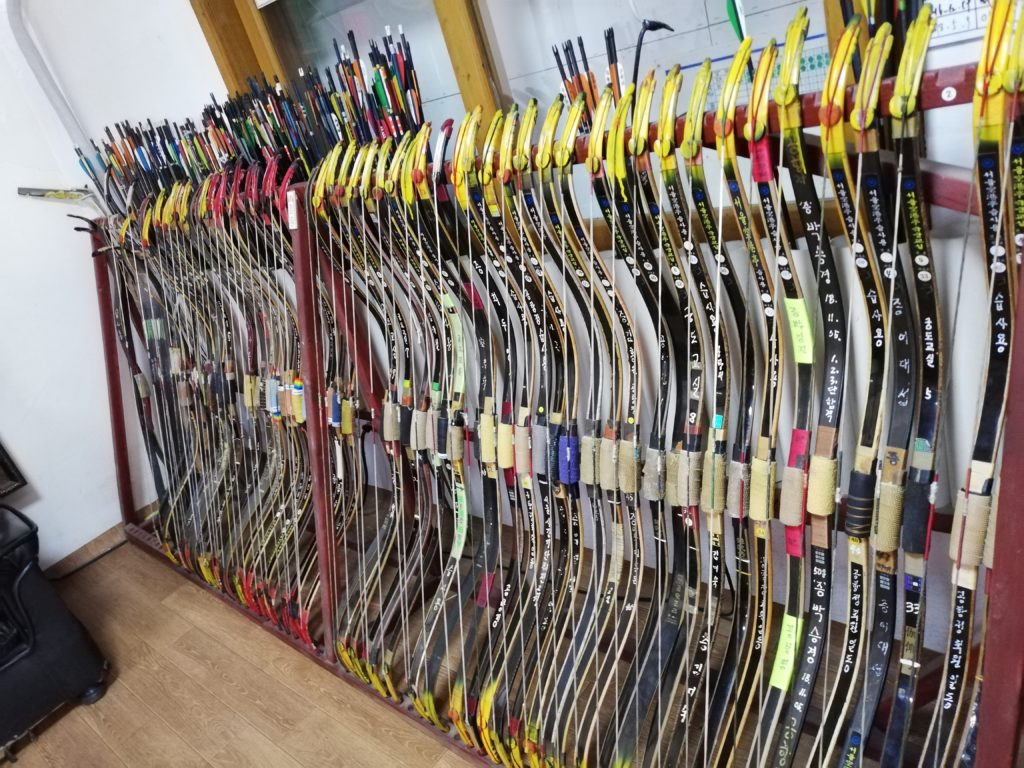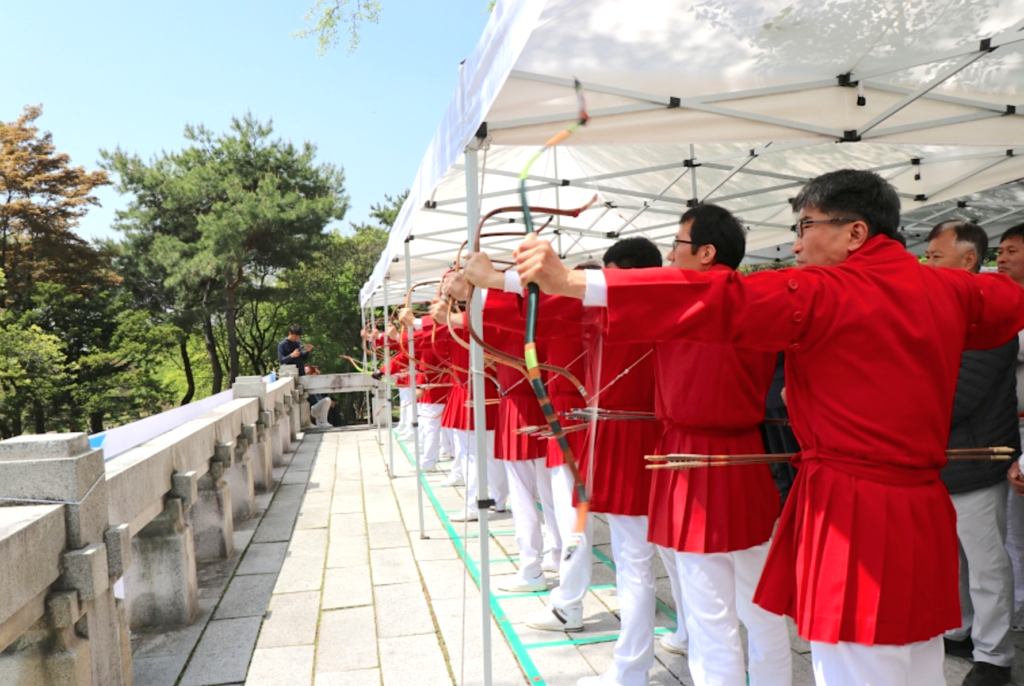In the final chapter in a short series on Korean traditional archery, Kristina Dolgilevica looks at how KTA has developed across the centuries.

In this concluding article I will try to bring all aspects I have investigated so far and perhaps place KTA into the modern archery scene. It is a difficult task not only because of language and translation differences, but because perhaps KTA still remains largely a very Korean ‘thing’, in the sense of a national cultural expression.
What is becoming clear to me is that the relationships between KTA and Korean international recurve archery is very much like taekwondo and taekkyeon, the traditional Korean martial arts.
Both KTA and taekkyeon are predecessors to their world-renowned modern counterparts, and both now walk in the shadows. Whether this is a good thing or not is hard to judge, but one thing is certain: KTA is an intrinsic part of the Korean identity and a source of national pride.
There were four decisive elements in Korean history directly linked to the future preservation and propagation of KTA: the compulsory military exam system, a strong tradition of dynastic courtesy and ritual, the development of the clubhouse and the development of the synthetic bow in the 20th century. I will look at each one in turn.
Military exam system
The single biggest contributor to the development of archery was the military exam system (MSE), under the rule of the Joseon dynasty (1392-1897, and became the Korean Empire).
Two nationwide selection processes were borrowed from China, ran simultaneously – the MSE for military talents, and the CSE (civilian service exam), which was essentially the same, and simply sourced more men for the military.
The specifics of entry and tests were subject to continuous revision and augmentation. Selection took place in progressive stages by means of elimination: the first stage tested martial arts only; the second martial arts and the classics, which included military strategy and Confucianism.
The third and final stage had the top men perform martial arts in front of the king, for a final division into classes.In the 15th century, the standards for the martial arts were lowered and entry numbers were raised – in one particular year the number of participants rose to 10,000 men.
This expansion corresponded with increased military unrest and constant threats of invasion from neighbouring Japan and China. Archery (musa) as martial art was tested in multiple categories, until the abolition of the service exam at the end of the 19th century.
Tests included: ground archery, tactics of long-range weapons; horseback skills, including horseback archery, and short range skills. Sword skills were not assessed in this category until the 16th century, and in a field where the Japanese surpassed the Koreans.
Matchlock firearms were introduced in the 17th century, but military archery did not disappear as a result of that (unlike the English longbow). In fact, by the 18th century six out of ten martial arts tests were archery related. Later in the century when musa tests were reduced to three subjects, archery remained.
One of the rounds was shooting at a 145m distance – the only KTA distance shot today. Horseback archers were graded on a set of five arrows shot- the number of arrows in a set shot by KTA archers today. These two tradtions remain as a vestige of the strong military culture of the past.
Courtesy, Dynastic Ritual and Respect
“A man of virtue has no use in competition. Yet if he cannot avoid it, let him compete through archery.” The Joseon dynasty adopted Neo-Confucianism as their ruling ideology, which advocated a non-violent approach, the ‘pen above the sword’ principle. Archery was an exception to the rule, because it had a deeper meaning under the teachings of Confucius.
Archery was an instrument for the cultivation of social and hierarchical respect, and served as a spiritual instrument for the development of morality. Confucianism remains a cornerstone of east Asian culture.
Even today, the rules of archery clubhouses operate on the major principles of ethics according to Confucius; at the head of which are the rules of social grace and courtesy, respect for the elders and members of higher ranks. In antiquity, archery was not only seen as a function of warfare, but one of self-discipline and physical development.
The latter function became the reason why KTA was revived in the first part of the 20th century. Civilian clubhouses started to spring up around Korea at a slow but steady rate. The last Emperor of Korea, King Gojong (who reigned 1897–1907) was the catalyst for this.
In the spirit of traditional imperial ‘yesa’ (ritual) culture, he set up an archery demonstration on the occasion of a royal visit by the German prince Heinrich. It impressed the Prince greatly, so the King proclaimed: “Let people enjoy archery to develop their physical strength”. That’s how the story goes, anyway, beginning a slow campaign of reopening archery clubs and the institutions of new ones.
Early 20th century
Before there was any significant rise in the role of the civilian clubhouse, there were two final hurdles that put a hold on the promotion of KTA. Japanese Colonial Rule (1910-1945) brought the number of active clubhouses down to 24 operational archery clubhouses by 1947. Then, the Korean War of 1950 once again brought KTA near to extinction.
But partly thanks to these events, a strong national sentiment gave rise to a deliberate and systematic renaissance of ancient and traditional practices and the arts, including KTA and taekkyon. There were 124 clubhouses in active use by 1970, and their number had almost doubled a decade later.
The laminated carbon bow, introduced in the 1980s changed KTA practice in a way that it made it accessible to more people much faster. The traditional horn bows required a lot of care and time to make, but synthetic bows are quick to manufacture and easy to maintain.
The limited supply of expensive natural materials, and the scarcity of traditional master bowmen, could have potentially further inhibited the growth of KTA.
Modern developments affected KTA in many ways, and some argue that the synthetic bow is not genuinely ‘traditional’. However, most Koreans promote the practice itself and do not differentiate between materials.
The price of membership is pretty reasonable to those who want to join: it does not usually exceed $150 annually, plus some minimal monthly collections for the general upkeep. At the entrance or at the front of the clubhouse you will always see a stone that states that everyone is welcome, regardless of their rank or level – another principle borrowed from Confucianism.
Most clubhouses, especially ones reinstated in their historic spots, are positioned on hills adjacent to Buddhist monasteries and in national parks. These beautiful scenic locations are excellent for promotion of the sport because the passers-by, foreign and domestic tourists, can observe the practice, inquire and sign up to learn ‘the way of the bow.’

Competition Rules
As in many other sports, competitions are a good way to attract and keep athletes practising and coming back for more. I was invited to watch an intercity competition near the city of Cheonju where I was shooting, featuring around two hundred male and female competitors over two days.
In this type of regional competition, a different city is chosen every weekend and representative teams from different cities travel to each location. There are both team and individual events, municipal, metropolitan and Nationals events.
The rules vary, but broadly: there are three targets at 145m distance, each archer will loose three sets of arrows, five arrows into each target, totalling 15 arrows in a competition. Every archer on the line takes turn and shoots one arrow at a time, for which they are given 30 seconds. There are seven spaces designated to one target.
Once all seven competitors have shot a set of five arrows, they will be called back to the second target when it is their turn, and another seven archers will take place on the first target, and so on in rotation, until all three sets are shot.
Competition referees hold a lot of authority- they are responsible for the safety and order of the venue and award hits and misses during the competition. Referees sit at the back of the range where the targets are, and will wave a flag when they see a hit or a miss. A hit is 1 point, a miss is a zero. This information is fed to the front of house and recorded.
Perhaps the strictest rule is that there should be absolutely no talking- no verbal assistance whatsoever, unless the archer has dropped an arrow or in case of equipment failure. An arrow dropped within 1m radius is considered for reshooting at the judge’s discretion.
With the exception of special events, all archers are to follow a strict dress code- white top and bottom with white sneaker, with appropriate belts. The club President (Sa Du) is an authoritative figure and will stand out from the rest, usually wearing a smart dark suit and a tie during such events – unless he is shooting.
Belt grading and entry competitions are held separately. During grading archers will shoot 45 arrows, from which the rank is counted. Archers are not allowed to shoot for more than two rankings a year, and after Master Dan 5, they can only try for one new Dan a year.
KTA Today
The latest figures from the Korean National Archery Association (a different entity from the one that oversees the Olympic programme) state that there are 380 clubhouses with 20,000 members in 17 provinces – around 1% of Korea’s population.
I have investigated some of the many reasons for this relatively low number. KTA is not taught to children and most practitioners are over forty. Olympic recurve on the other hand is taught to youth everywhere: elementary, middle and high schools, universities and various other military, national and private companies.
There is no monetary reward or professionalism as there is for recurve, either for athletes or their coaches. Competition readiness is affected as a result – the more you can practice and the longer you shoot, the better you get.
Taking into account the limitations mentioned above, plus the intricacies of form, technique development, shooting distance, the strict belt grading system and how difficult it is to get the first grade (25 of 45 hits), the vast majority of archers either remain without any grading at all, or having achieved the first level stay at it for a few or many years.
I am by no means trying to put anyone off trying, just highlighting the concerns and thoughts of those who are directly involved in it today. I do believe however, that KTA has a great future as a discipline, one reason being that people will always love everything ‘traditional’, because traditional practices introduce culture, and everyone wants to develop their cultural side.
On the other hand, the competition for other fields in archery is getting tougher every year, and as with any other sport, attention will be widened and drawn to other fields of play. The success of Japanese kyudo as a cultural totem around the world is an example, with many dojos and practitioners of all nationalities.
The rapid growth of the barebow class on the world scene last year is another positive nudge to the growing curiosity and active involvement in traditional archery disciplines. KTA has a bright future, so spread the word and lock your thumbs!

